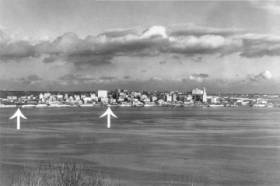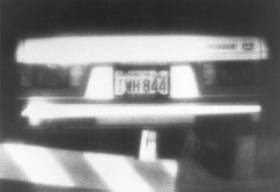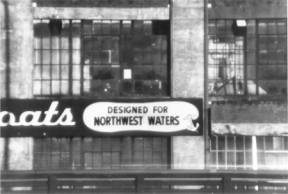Almost a decade ago I very carefully clipped an ad from Law Enforcement Technology Magazine, saying to myself “I didn’t know that capability existed! I want one of those!” This past weekend I found the clipping in the garage. The ad (for Questar optics) still doesn’t disappoint:
 Image with a 55mm lens from 3.5 kilometers
Image with a 55mm lens from 3.5 kilometers
 Image of what’s at the left arrow, from 3.5 kilometers away with a Questar Field Ranger 180
Image of what’s at the left arrow, from 3.5 kilometers away with a Questar Field Ranger 180
 Image of what’s at the right arrow, from 3.5 kilometers away with a Questar Field Ranger 90
Image of what’s at the right arrow, from 3.5 kilometers away with a Questar Field Ranger 90
Questar’s Field Model is slightly less rugged than the Field Ranger. Yeah, I still want one.

Wonder what the pricing on those tends to run?
Not that I can see actually needing one, outside of the cool factor. Until, that is, I get into the Boomershoot scale of distance on a regular basis.
Jim
Sunk New Dawn
Galveston, TX
Huh… 1.0 arc second Dawes on a 3lb field 90 eh? nice. $3000 though.
I’ve got a Celestron 100mm F-ED refractor that can resolve down almost to the same ( 1.16 Dawes I believe)…. But mine is made in Taiwan, is a foot longer, and weighs six pounds without the mount (but at least it only cost me $700).
Also… the numbers they’re claiming are a little weird.
Actually, I’m kinda wondering how they got a 90 down to 1.0 arc second, because the Dawes limit on a 90 with conventional optics is 1.29, with a Rayleigh of like 1.57. Even with the best coatings, the observable limit is more like 1.31 (which is what I saw in some of their other documentation, a claimed 1.3).
I realize it’s a hybrid Maks-Cass and there are some resolution boosting tricks you can do with the reflectors, but don’t see how they could get that resolution with that aperture. 1.3 I believe, 1.0 I don’t.
Still, it’s a very nice scope, and for an American made piece, at that light weight, good value for the money.
With response there, I’m guessing it’s going to be very color accurate, with very little chromatic, bleeding, or fringing as well.
Mine isn’t that good by a ways. The coatings and glass must be way better on the Questar. And of course, being a relatively low cost refractor, there’s going to be more total distortion, diffraction, and reduced transmissivity just from the additional optical elements (though at least all the elements are Flourite ED).
When all is said and done, I think I’ll probably have about the same useful observable resolving limit as the Questar will, making up for the poorer coating and additional optics with the extra size…
…only mine is twice as long, weighs twice as much, and has four times as many elements to break (though I did only pay 1/4 the price).
I’d guess realworld on both is probably around 1.57 when all is said and done, given total luminance and diffraction.
… which would be good enough to resolve a .02″ hole at 1000 yards by the way… if we lived in a vacuum, which of course we don’t.
For surface observation at sea level in clear air on a mirage free day, I usually apply a fudge factor of 10 to the resolution limit as to what my eyes can actually pick out against a high contrast background… with about 40x being about the highest useful magnification for either (you dont want to go much below a 2.5mm exit pupil or you lose resolution).
Given that, either one should pick up a .223 or a .308 on a shoot-n-see or the lead smear from the bullet hitting fourescent paint on steel, at 1000 yards, without a problem.